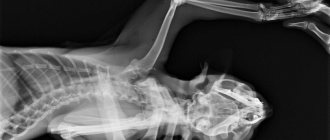Toxoplasmosis is a protozoal invasion characterized by a wide variety of course options and polymorphism of clinical manifestations. In 1972, WHO experts included toxoplasmosis among the zoonoses most dangerous to human health, and later, due to the spread of HIV infection, it was recognized as one of the few opportunistic infections of protozoal etiology.
The causative agent is the coccidia Toxoplasma gondii, an obligate intracellular parasite from the Sporozoa class, which belongs to the phylum of protozoa. The final host of T. gondii is considered to be the domestic cat and other representatives of the cat family, in whose body both asexual reproduction of Toxoplasma occurs and the formation of germ cells (oocysts), which enter the external environment with feces, where they exhibit high resistance to various unfavorable factors (including soil with sufficient moisture can last up to 2 years). Oocysts from the external environment enter the human body or other intermediate hosts (many wild and domestic animals and birds) with contaminated food or water, where the asexual reproduction cycle of the parasite occurs. Sporocysts released from oocysts in the intestine form tachyzoites, which, migrating through the body, affect many tissues, mainly the brain and muscles. The tachyzoites then turn into true tissue cysts, in which thousands of bradyzoites slowly multiply. In people without immune system disorders, tissue cysts remain latent throughout life, but with a significant decrease in immunity, the infection often reactivates with the development of clinical variants of the disease.
Toxoplasmosis invasion has a wide, almost ubiquitous distribution: from 500 million to 1.5 billion people around the globe are infected with toxoplasma. The prevalence of the population in different countries depends on sanitary and hygienic conditions, dietary habits, the influence of environmental factors, the frequency of immunodeficiency conditions, etc. Indicators of infection of the population in various regions of Russia range from 15 to 50%, and the frequency of congenital toxoplasmosis among newborns is on average 3-50%. 8 children per 1000 births.
The source of the pathogen is the domestic cat and many species of wild and domestic animals. However, cats shed oocysts in their feces for a short period (1-2 weeks) and only at the age of 4-5 months, so infection directly from a cat, the definitive host of the pathogen, is rare (for example, infection of a child through contact with cat feces in a sandbox and non-compliance with hygiene rules). Infection of people occurs in various ways: nutritional, contact, congenital (transplacental), parenteral, infection of medical personnel in contact with blood is possible. People often become infected by eating products made from intermediate host meat that has not undergone sufficient heat treatment (grilled chicken, shawarma, shish kebab, raw minced meat), poorly washed vegetables, etc. Depending on the mechanism of infection, acquired and congenital toxoplasmosis are distinguished.
Acquired toxoplasmosis
in adults it is more often asymptomatic - in 9095% of infected individuals no significant manifestations are observed. Approximately 5–7% of women are first infected during pregnancy; in these cases, toxoplasmosis is especially dangerous: it causes early termination of pregnancy, stillbirth, the birth of children with developmental anomalies, damage to the central nervous system, etc. When women are infected during the entire period of pregnancy, on average 61% of healthy children and 39% of children with congenital toxoplasmosis are born. During a primary infection during pregnancy, transmission of the pathogen to the fetus in acute toxoplasmosis occurs in 40–50% of cases; when the fetus is infected in the first trimester, a severe form occurs in 40%; when infected in the second or third trimester - in 17.7% and 2.7 % of cases respectively. Toxoplasmosis has a high pathogenetic significance for HIV-infected individuals when clinical forms of the disease develop as a result of reactivation of a latent infection. In Russia, toxoplasmosis encephalitis is currently the main cause of central nervous system damage in AIDS patients (usually with a CD4 lymphocyte count of less than 0.1 x 109/μl).
Congenital toxoplasmosis
– an acute or chronic disease of newborns that occurs when the fetus is infected with Toxoplasma during intrauterine development. It requires special attention due to the difficulty of diagnosis and the possibility of severe consequences of the disease. The only method of preventing congenital toxoplasmosis is examination of pregnant women to identify specific antibodies.
The clinical manifestations of infection in the fetus are determined primarily by the period of pregnancy during which the infection occurred and by the route of penetration of the pathogen (an unfavorable outcome is mainly associated with the hematogenous route of transmission of infection). There are three clinical forms of congenital toxoplasmosis, which are successive stages of development of the infectious process: acute generalized form (with hepatosplenomegaly and jaundice), subacute (with symptoms of encephalitis) and chronic (with symptoms of postencephalic defect).
When infected in the first and second trimesters of pregnancy, when the generalization stage of the process ends in utero, spontaneous miscarriages, severe developmental anomalies incompatible with the life of the fetus and child, as well as the most severe damage to the central nervous system and eyes, more often occur. In the subacute stage of the disease, a child is born with severe symptoms of central nervous system damage - symptoms of meningitis or meningoencephalitis, with a clinical picture of focal or diffuse damage to the meninges. In cases where the acute and subacute stages have passed in utero, the child is born with a chronic form of toxoplasmosis in the presence of severe damage to the central nervous system (a picture of a postencephalitic state) and eyes (from chorioretinitis to microphthalmia).
When infected in the third trimester, asymptomatic forms often predominate in newborns. However, if the infection occurred shortly before the birth of the child, then the stage of generalization that began in utero continues after birth and is manifested by a variety of clinical symptoms.
The acute form of congenital toxoplasmosis is detected most often in premature infants and has a very severe course, similar to sepsis. The mortality rate of infected newborns ranges from 1 to 6%. Surviving children suffer from mental retardation or other manifestations of central nervous system disorders.
Biology
Toxoplasma enters a cat orally, by eating an infected mouse, eating raw infected lamb or pork, or licking a mud-stained paw. Parasites are ubiquitous, but only the cat's intestines are adapted for their sexual reproduction. Oocysts (fertilized eggs, oocyst) are formed, which are excreted in the feces.
recommended articles:
- Notoedrosis or pruritic mange in cats
- How to identify and treat toxoplasmosis in dogs?
Toxoplasmosis in cats rarely causes clinical symptoms. Therefore, a person who cleans a cat's litter box runs the risk of becoming infected. The oocyst is able to penetrate through skin pores. However, if the toilet is cleaned daily, there is no risk of infection. The oocyst, before becoming invasive, matures in the external environment for at least a day. Excretion of oocyst continues for 21 days, after which the cat ceases to be a source of human infection.
Another group of Toxoplasma is spread by blood throughout organs and textures. In most cases, the immune system renders the parasite in an inactive state. It continues as long as the body’s defenses are fully functioning. Only then does Toxoplasma become active and begin its destructive action.
Cat feces contain oocysts that are dangerous to humans
The development cycle of Toxoplasma consists of sexual and asexual reproduction. The first is possible only in cats. For cats, Toxoplasma is contagious in all phases; for other warm-blooded animals and humans, only oocysts are contagious.
The causative agent of toxoplasmosis is not highly resistant to negative environmental factors. It dies when heated above 55°C and frozen, but liquid substrates keep it viable for years.
| Description | |
| Nutritional route | Infection occurs when eating contaminated products of animal origin (for example, meat, milk, eggs) that have not undergone proper heat treatment. According to the results of studies, a particularly large amount of toxoplasma can be found in the meat of pigs and sheep. |
| Vertical path | This route of transmission is also called transplacental, since transmission of Toxoplasma occurs through the placenta from mother to fetus. The transplacental route of transmission of toxoplasmosis is the most dangerous, since during pregnancy the introduction of infection can provoke serious pathological changes in the unborn child (for example, mental retardation, epilepsy, intracranial pressure, blindness). Infection of a child at an early stage of pregnancy (first trimester) often leads to fetal death. |
| Fecal-oral route | The results of the studies have proven that cats infected with Toxoplasma are capable of releasing about two billion oocysts into the environment in two weeks, which are considered infectious for two years. Toxoplasma is transmitted by ingesting dust along with parasites in places where an infected cat has defecated (for example, a sandbox, a vegetable garden, or a garden). The infection can also be acquired through the mouth using contaminated hands after contact with a sick cat, whose fur usually retains particles of its feces. |
Symptoms of congenital toxoplasmosis
The congenital form of the disease occurs in the fetus when a woman becomes infected with toxoplasmosis during pregnancy.
Depending on the duration of pregnancy, congenital toxoplasmosis can be divided into two groups:
• early congenital toxoplasmosis, in which the mother and, consequently, the fetus are infected in the first months of pregnancy;
• late congenital toxoplasmosis, in which a pregnant woman becomes infected with toxoplasmosis and transmits the disease to the fetus in the second half of pregnancy.
Often, early congenital toxoplasmosis leads to fetal death, in the form of spontaneous abortion or stillbirth. With late congenital toxoplasmosis, a child may be born with signs of generalized toxoplasmosis (for example, an enlarged liver, spleen).
The following forms of congenital toxoplasmosis exist:
• acute form;
• chronic form.
| Symptoms of the acute form of congenital toxoplasmosis | Symptoms of the chronic form of congenital toxoplasmosis |
| • pronounced signs of intoxication; • fever; • enlarged liver and spleen; • yellowness of the skin; • maculopapular rash in the form of papules of purple, flesh-colored or dark burgundy color, affecting mainly the trunk, face and limbs; • headache; • inflammatory eye damage; • encephalitis. | • hydrocephalus – accumulation of fluid in the brain, leading to deformation of the skull and pathological impairment of the organs of hearing and vision; • mental retardation, which manifests itself as mental retardation; • chorioretinitis (inflammation of the choroid); • epilepsy, which is manifested by frequent convulsive attacks; • atrophy of the optic nerves; • as a complication, blindness and progressive brain damage are possible, the latter often leading to the death of the patient. |
Symptoms of acquired toxoplasmosis
The following periods of the disease are distinguished:
— incubation period;
- prodromal period;
- peak period;
- period of convalescence.
| Period of illness | Duration of the period | Description of the period |
| Incubation period | from three days to two weeks | Characterized by the proliferation of pathogens and the accumulation of toxins. This period lasts from the moment the microorganism enters the body until the first symptoms appear. |
| Prodromal period | within one to two weeks | Characterized by the appearance of the first nonspecific clinical symptoms (for example, fever, malaise, enlarged lymph nodes). This period can begin acutely or gradually. |
| High period | two to three weeks | There is a subsidence of nonspecific symptoms of the disease. The vital activity of the body’s immune cells is also inhibited, which subsequently leads to the development of pathological conditions of the cardiovascular, musculoskeletal and nervous systems. |
| Convalescence period | in the third – fourth week of the disease, a gradual disappearance of all clinical symptoms is observed | It is characterized by the disappearance of signs of the disease and the onset of stable immunity, which is developed for life. |
In a healthy person, this disease, as a rule, proceeds almost unnoticed, without pronounced symptoms. The patient may experience symptoms such as a slight increase in body temperature, weakness, headache, and swollen lymph nodes, which usually disappear within one week. However, if a person experiences a decrease in the body’s defenses (for example, with HIV infection), then toxoplasmosis occurs more severely, affecting various systems, organs and tissues (for example, the nervous system, heart, eyes, skeletal muscles).
There are three forms of acquired toxoplasmosis:
• acute form;
• chronic form;
• latent form.
Acute form
This form in most cases is characterized by an acute onset of the disease.
In the acute form, the patient may experience the following signs of the disease:
• increase in body temperature to 38 – 39 degrees;
• signs of intoxication of the body, for example, loss of appetite, pain in muscles and joints, weakness (develop due to the internal effects on the body of toxins released by the causative agent of the disease);
• enlargement of lymph nodes, in most cases cervical and occipital (increase in size, become dense);
• hepatosplenomegaly (enlarged liver and spleen).
In addition to the above symptoms, this form may cause various pathological rashes on the skin (for example, a spot, papule, vesicle), as well as signs of brain damage (encephalitis and meningoencephalitis).
Chronic form
Characterized by various manifestations over a long period of time. With this form of the disease, there is a long-term (over several months) increase in body temperature within 37 - 37.9 degrees, as well as manifestations of intoxication of the body, which can subsequently lead to damage to various organs and systems (for example, damage to the eyes, heart, muscular system).
During this period, the patient may be bothered by symptoms such as increased weakness, nervousness, headaches, memory impairment, as well as pain in the muscles and joints. It should also be noted that the chronic form is characterized by enlargement of the lymph nodes - usually cervical, supraclavicular, axillary and inguinal.
Latent form
This form of toxoplasmosis is characterized by an asymptomatic course, and, as a rule, the disease is detected only after research.
Prevention of toxoplasmosis is as follows:
• compliance with personal hygiene rules;
• reducing contact with cats;
• avoiding eating raw, poorly fried or cooked meat or minced meat;
• when consuming vegetables, fruits or berries that come into contact with the ground, they should be washed thoroughly;
• if you have a cat at home, it is recommended to regularly examine the animal for toxoplasmosis;
• when planning pregnancy, a woman should be tested for toxoplasmosis;
strengthening the body's defenses (regular hardening, good nutrition, maintaining a healthy lifestyle).
How is Toxoplasma transmitted?
Toxoplasma enters humans mainly through the oral-fecal route. In addition to contact with the cat's litter box, the danger for children is playing in the sandbox, which stray cats use as a toilet, a toy that has been touched by the cat's paws, which have buried their own feces.
Many people are unaware that they are home to Toxoplasma. But there is something good in the bad: having become infected with Toxoplasma, the body produces antibodies against it. If a woman was infected several months before conception, her immune cells have time to develop a weapon that will protect the mother and prevent the pathogen from passing through the placental barrier to the defenseless embryo.
Contact with the litter box is not the only way to get toxoplasma from your pet. When cat feces enter the soil, they spread oocysts. Vegetables, berries, fruits are infected with oocyst. If you don’t wash your hands once, the parasite penetrates inside the person.
Working with gloves protects against toxoplasma
Examination of patients with HIV infection
Diagnosis consists of regular monitoring of immunoglobulin G titers using serological methods. Titration of immunoglobulin M is not informative since in most HIV-positive people the level of antibodies of this group is extremely variable.
Direct detection of the pathogen by microscopy of tissue samples or infection of laboratory animals is usually not necessary. The diagnosis can be established quite accurately through serological diagnosis and the presence of a specific clinical picture of toxoplasmosis. In HIV-positive patients it is more pronounced, which greatly simplifies the diagnosis.
Pregnancy and toxoplasmosis
The danger to the embryo is the initial infection of the pregnant woman with Toxoplasma. In the first third of the gestation period, the placental threshold is overcome by parasites in 20%, in the middle - 30%, and in the end - 60% of situations. The older the fruit, the more resistant it is to invasion. If infection occurs in the first trimester and toxoplasma manages to overcome the placental barrier, the fetus dies. If this happens before 24 weeks, it is recommended to terminate the pregnancy, since there is a high probability of having a child with a hereditary disease. Infection in the last trimester is most often safe for the baby.
Those who have cats living in their home constantly for many years are protected from the risk of infecting a developing fetus with toxoplasma. In this case, the potential mother is almost 100% infected, and her body has developed immunity against the parasite. This means that the unborn baby is not in danger.
Test for toxoplasmosis
Forms of the disease
Toxoplasmosis can be congenital or acquired; it affects men less often. In type 2 disease, there are three forms of progression, which are described in more detail in the table:
| Type of disease | Features of symptoms |
| Acute toxoplasmosis |
|
| Chronic toxoplasmosis |
|
| Latent |
|
Diagnostics and therapy
If we are talking about a cat, then a reliable way to identify toxoplasma is PCR. Women planning a pregnancy are required to undergo an ELISA test. The concentration of immunoglobulins G and M is determined. It is important for the diagnostician to find out not only the presence of the pathogen, but the time when the infection occurred.
When factor G is detected in the absence of M, a woman has nothing to worry about. She was infected a long time ago, and her body has already developed immunity. Such results are obtained in most cases.
If both factors are present, this indicates that the infestation occurred in the past year. The study is repeated 3 weeks later. If the concentration of G increases, the patient develops toxoplasmosis and must be treated. The most alarming situation is when only factor M is detected. This indicates that the infection occurred recently and the fetus is in danger. The absence of both factors indicates that the woman is free from Toxoplasma. Special care is required when handling cats.
Sampling of amniotic fluid
PCR research is not relevant. It confirms the presence of the parasite, but does not establish the timing of infection. If the mother’s invasion occurred recently (only globulin M is present), a month after the analysis it is determined whether the fetus is infected. A sample of amniotic fluid is taken through the abdominal wall with a thin needle. If globulin M is detected, an ultrasound is performed. If pathological changes in the placenta and fetus are detected, it is recommended to terminate the pregnancy.
In an alternative situation, treatment is prescribed. The use of anti-Toxoplasma drugs is allowed from 12…16 weeks of gestation. Newborns are subjected to ELISA analysis.
What it is?
Toxoplasmosis is an infectious disease caused by Toxoplasma gondii. The disease can be asymptomatic, with manifestations of lymphadenopathy, mononucleosis-like symptoms, up to damage to the central nervous system in immunocompromised individuals.
Newborns may have chorioretinitis, seizures, and mental retardation. The diagnosis is confirmed serologically, HCC and histologically. Treatment is with perimethamine in combination with sulfadiazine or clindamycin. Glucocorticoids are used for chorioretinitis simultaneously with the main therapy.
Prevention
Preventive measures make sense if there is a pregnant woman in the house. Testing for toxoplasmosis should be done several months before the expected conception. If a negative result is obtained, communication with the cat must be stopped. You can only work in the beds with gloves; wash vegetables and fruits thoroughly. Avoid infecting your cat with toxoplasmosis.
We invite you to join our Zen channel and group on VKontakte or Odnoklassniki, where new articles for pet owners are published.
Similar articles:
- What should you protect your pets from during the New Year holidays?
- What indoor plants can harm cats?
- What dangers do Christmas decorations pose for cats?
Material for research
To detect specific antibodies to Toxoplasma, blood is drawn from a vein; the procedure does not require any special preparation. Any biological material is suitable for carrying out a PCR reaction - blood, saliva, tissue samples, other biological fluids (cerebrospinal fluid, urine).
If there is a need to diagnose toxoplasmosis in the fetus, blood sampling from the umbilical cord is possible. The procedure is rarely prescribed because it is associated with a high risk of complications and premature termination of pregnancy. A more gentle method is to take amniotic fluid for analysis by puncture. These methods are used when the results of specific tests on a pregnant woman with suspected toxoplasmosis do not provide sufficient clarity of the diagnosis.
Indications for the use of various laboratory tests and features of interpretation of results in different categories of subjects
Depending on the category of the patient (age group, risk group), the use of different sets of diagnostic techniques is indicated. The correct choice of diagnostic methods is especially important in cases of suspected toxoplasmosis in pregnant women.
Modern methods of treatment
Unfortunately, it is very difficult to completely eliminate the parasite from the body. Toxoplasma forms cysts in which they can persist in tissues for a long time. They are resistant to medications. Patients with compromised immune status require especially intensive treatment.
Antibacterial agents, chemotherapy drugs, and their combinations are used. Also, treatment is aimed at increasing immunity.
During pregnancy, treatment is carried out no earlier than 12-16 weeks. Chemotherapy drugs are used. For sufficient effect, two courses are carried out with a break of 1-1.5 months. If the patient became infected before pregnancy and has no clinical signs of pathology, treatment is not carried out. The intake of medications is controlled not only by the infectious disease specialist, but also by the doctor who is managing the pregnancy.
Examination in Medart
At the Medart Medical Center, a full range of serological tests are performed to detect toxoplasma in the patient’s body. An immunological test to identify specific immunoglobulins is part of comprehensive STD tests intended for couples planning to have a child. It is possible to take blood and other biological fluids to determine the presence of toxoplasma and clarify the clinical picture of the disease.
High-precision modern equipment allows you to obtain accurate research results in the shortest possible time.
Advantages of Medart Medical Center:
- Qualified specialists.
- The ability to quickly obtain accurate research results.
- Affordable price.
The medical center provides a full range of services, from preliminary appointments and consultations to establishing and clarifying the diagnosis and prescribing effective treatment regimens and prevention of toxoplasmosis and other diseases.
Animals at risk
Stray cats are primarily susceptible to the disease. Having frequent contact with rodents, almost all street children are infected with a dangerous parasite. The risk of contracting toxoplasmosis is also high in pets that have free access to the outdoors.
The risk group includes cats whose owners feed raw, uncooked meat and other natural products.
Veterinary experts note that young animals under the age of 1 year and after 7 years are more predisposed to the causative agent of a parasitic disease than pets aged 1 to 6 years.
This tendency is associated with the functioning of the animal’s immune system. For the same reason, weakened, sick, exhausted pets are also easy targets for toxoplasmosis pathogens.
Keeping animals in unsatisfactory sanitary conditions, drinking dirty water, and lack of regular disinfection of trays and care items increases the risk of infection.
Is it possible to get infected from a cat to a person?
Being an anthropozoonosis, toxoplasmosis of domestic animals represents
potential danger to humans. The risk of infection is especially high when a sick animal releases the pathogen into the environment through saliva, nasal discharge, sneezing, or feces.
As a rule, this occurs within the first 2 to 3 weeks after a cat is infected with Toxoplasma.
Oocysts released during cat bowel movements are one of the most common ways of infecting humans. When cleaning the tray without following sanitary measures, the risk of infection increases sharply.
Often, a person becomes infected with toxoplasmosis when saliva or nasal discharge from an infected animal gets on the mucous membranes of the mouth in the initial stage of the disease.
Less commonly, a person can become infected from a furry pet when oocysts of the parasite come into contact with damaged skin and mucous membranes of the body. This can happen when caring for an infected cat.
To learn about the cases in which a person can become infected with toxoplasmosis from a cat, watch this video:











